“He’s a man given a name for his victories in space
He’s honored by history… We call him ‘Ace’ “
By: Frank Kibbe, 56th Fighter Group
In the skies over Europe from 1943 to 1945, the 56th established itself as the USAAF’s top fighter group and created a legacy that will never be surpassed.
Lineage and Evolution of the 56th Fighter Group
This storied unit, “Zemke’s Wolfpack,” by itself is represented on Air Force TWS with sixty-four registered members. However, its history with, currently, sixty-eight other numerically associated air and ground units (e.g. Wing, Supply, Medical, etc.) includes hundreds more airmen under and bearing the original insignia right up to the present time with 56th OG. A summary of its full parent lineage, not including subordinate squadrons, would include: AAC 56th Pursuit group 1940-41, then the AAF 56th FG itself until 1946, redesignated 56th Fighter Interceptor Group 1950-52, 56th Fighter Group (Air Defense) 1955-1961, 56th Tactical Fighter Group 1985-1991, and 56th Operations Group 1991- present.
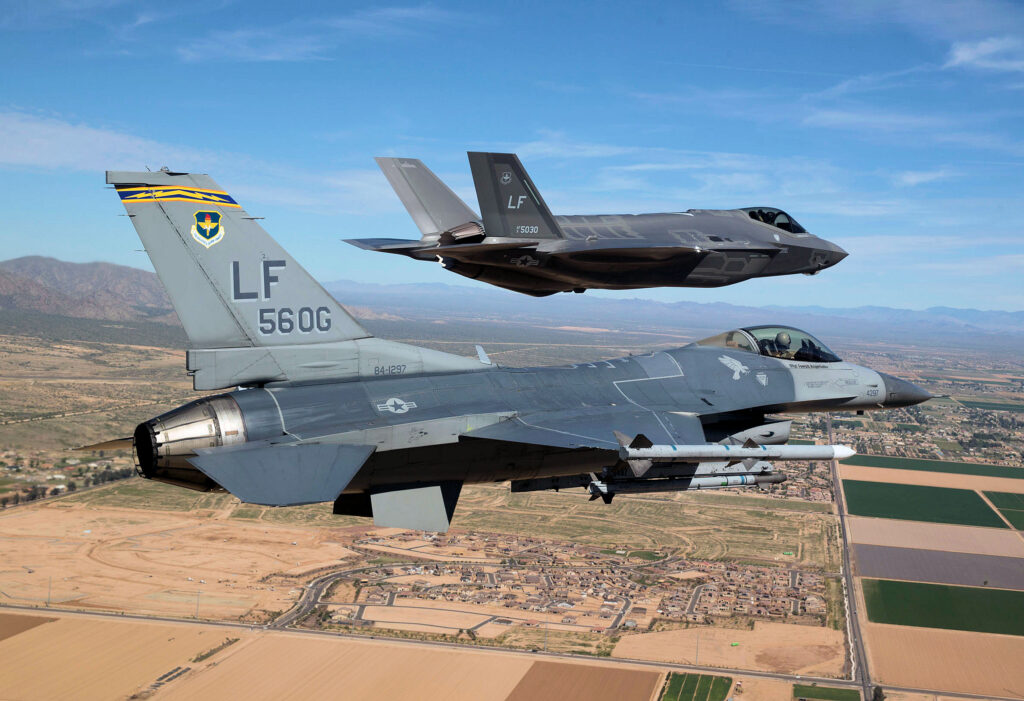
Assignments, Aircraft, and Honors
Chronologically, the Group has been stationed at Savannah AB, Charlotte AAB, Teaneck Armory, RAF Kingscliffe, RAF Horsham St Faith, RAF Halesworth, RAF Boxted, RAF Little Walden, Camp Kilmer, Selfridge Field, O’Hare Intl Airport, K.I. Sawyer AFB, MacDill AFB, and Luke AFB. At various times it was assigned to the Southeast Air District, III Interceptor Command, I Interceptor Command, New York Defense Wing, VIII Fighter Command, 4th Air Defense Wing, 66th Fighter Wing, 8th Air Force, 15th Air Force, 4706th Air Defense Wing, 37th Air Division, Sault Sainte Marie Air Defense Sector, and 56th Fighter Wing with attachments to 17th Bombardment Wing (L), III Interceptor Command, 65th Combat Fighter Wing (VLR) and 30th Air Division. Over its long service 56th FG pilots alone have flown the P-35, P-36, P-39, P-40, P-47, P-51, F-80, F-86, F-94, F-101, F-15 and F-16 aircraft.
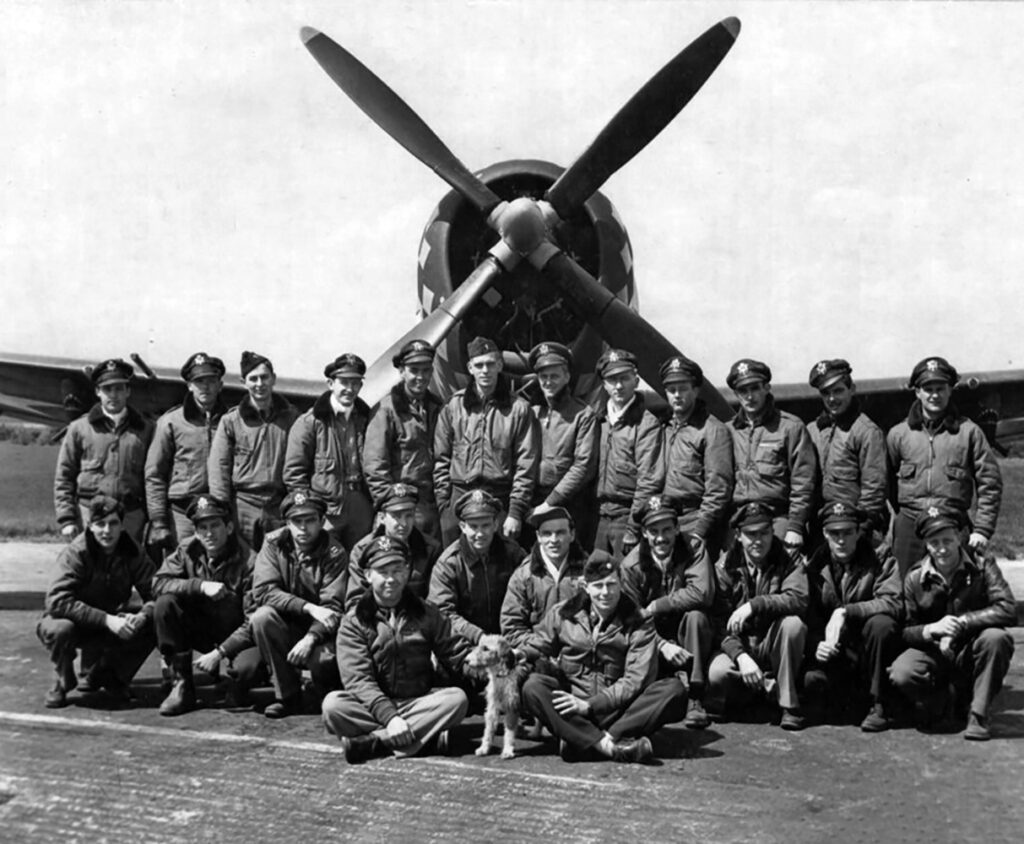
Their air and ground personnel have earned unit honors including: World War II and American Theater Service Streamers; World War II Air Offensive, Europe Normandy, Northern France, Rhineland, Ardennes-Alsace, and Central Europe Air Combat Campaign Streamers; an EAME Theater Armed Forces Expeditionary Streamer; Distinguished Unit Citations for ETO, 20 Feb-9 Mar 1944 Holland and September 18 1944; as well as Air Force Outstanding Unit Awards in 1994-96, 96-98, 2000-01, 2003, 2005-06, 06-07, 07-08, 08-09, 09-11, and 2012-16. Their descendant, the 56th Operations Group, is the second largest in the United States Air Force with thirteen separate reporting organizations (second only to the 55th Operations Group). In fiscal year 2006, the 56th Operations Group flew 37,000 sorties and 50,000 hours while graduating 484 F-16 students. With huge spaces in the western Arizona desert and clear weather skies for most of the year, Luke AFB and its ranges have been an important training asset for the USAF for many years. This is likely to remain the case for the foreseeable future. The mission of the 56th OG is to train Air Battle Managers, command and control operators, F-16 Fighting Falcon and F-35A Lightning II fighter pilots.
Early Formation and Deployment of 56th Fighter Group
The 56th was activated on January 15 1941 at Savannah AAB, Ga. Expansion of the 56th Fighter Group began after the move to Charlotte AAB, NC, in May 1941, when they were equipped with a small number of P-39 and P-40 aircraft. Intensive training took place in Charleston, SC, in December 1941, and from January to June 1942, at airfields in New York and at area headquarters, including Mitchel Field, NY. Here they flew in air defense patrols. Selected to train with the new P-47B, they received the first aircraft in June of 1942. The Group then moved to Bridgeport, MAP, CT, on July 7, 1942, and continued testing and training with early P-47s. Alerted for overseas duty in December 1942, they sailed on the Queen Elizabeth on January 6, 1943, and arrived in Gourock on January 11 that year. The 647 aerial victories placed The Group on top of the 8th AF in that category, and they ended second only to the 4th Fighter Group in combined air and ground victories. The Group finished with an eight-to-one kill ratio. The unit’s radio Call signs were: YARDSTICK (A Group) and ASHLAND (B Group). These changed on April 22, 1944, to FAIRBANK (A Group), SUBWAY (B Group), and PANTILE (C Group).
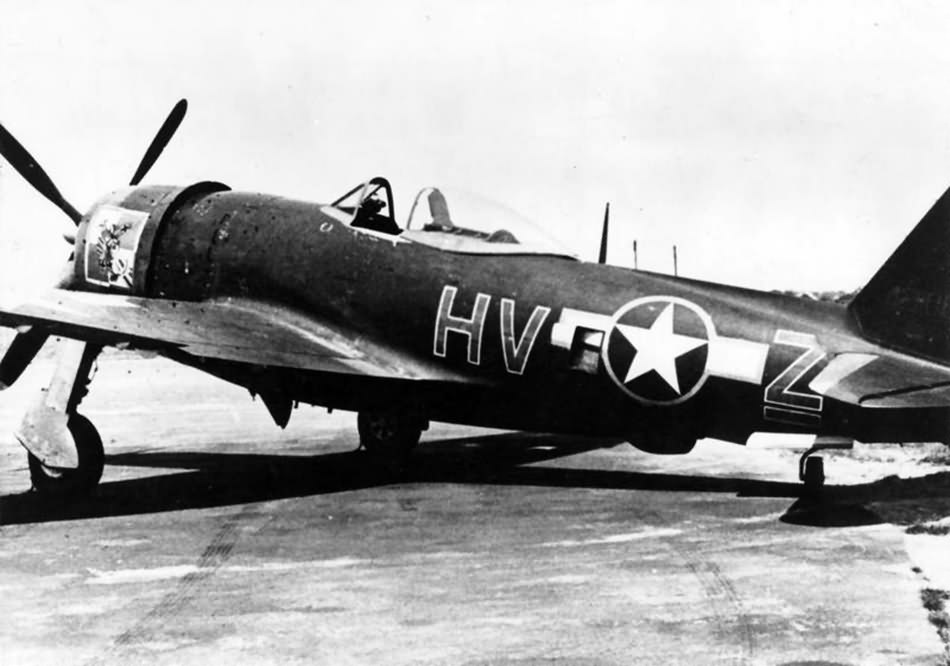
Combat Success and Aces of the 56th Fighter Group
The original unit’s first mission was launched on April 13, 1943, and its last one of that era on April 21, 1945, with a theater total of more than 400 missions, 128 unit aircraft MIA, while claiming 674 air kills plus 311 on the ground. It destroyed more enemy aircraft than any other 8th AF fighter Group. Led by Col. Hubert A. Zemke in 1942 and ’44, they had more fighter aces than any other Fighter Group, including top-scoring aces Francis “Gabby” Gabreski (for whom the Air National Guard base in Westhampton, New York, is named) and Robert Johnson. Notably, Gabreski’s daughter-in-law, USAF LtGen Terry, and son, Col. Donald, and great-grandson, Mark, also wore the Blue. The 56th was the first USAAF group to fly the P-47 Thunderbolt (aka “The Jug”) and the only 8th AF Group to fly a P-47 throughout the Second War. Their aircraft went to depots in September 1945.
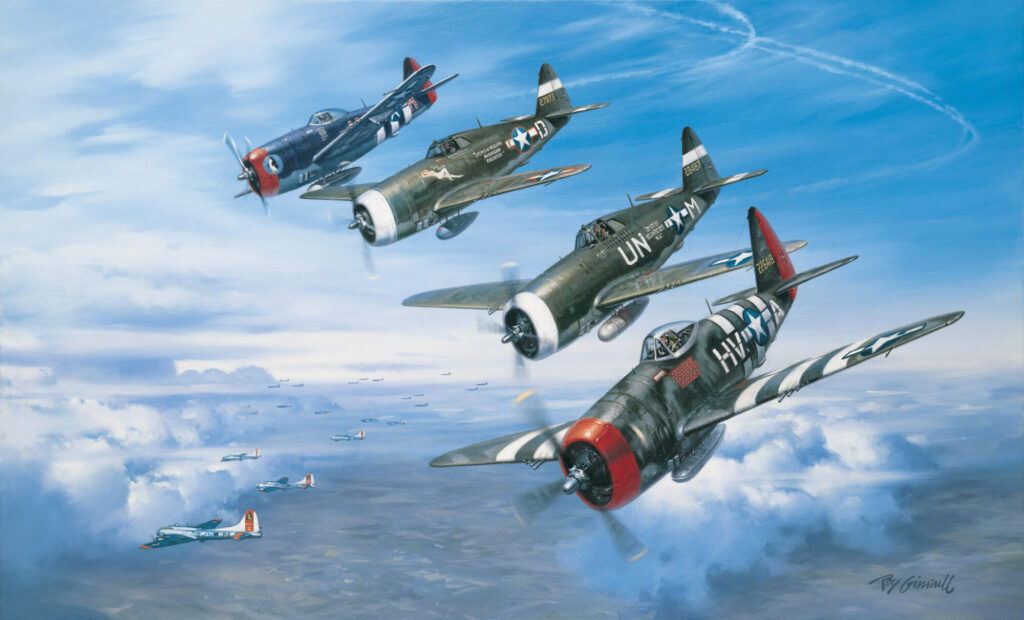
The remainder of the personnel departed for RAF Little Walden. Subsequently, it returned to the United States, sailing on the Queen Mary on October 11, 1945, and arriving in New York on October 16, 1945. The Group was formally reestablished at Selfridge Field, Michigan, flying P-47s and P-51s until 1947, then transitioning to P-80s. It moved to O’Hare International Airport, IL, in August 1955, equipped with F-86Ds. They were reestablished as the 62nd Fighter Interceptor Squadron with F-101 Voodoos until 1969. The unit’s designation was given to a special operations wing in Thailand in 1967.
Heraldry and Motto of the 56th Fighter Group
The formal Institute of Heraldry description of their emblem is: “… The insignia of the 56th FG was devised while the Group was training in the eastern US; the emblem received official approval on April 4, 1942. It was expected that the Group would eventually be equipped with P-38 Lightnings, hence the double lightning flash of the chevron. This served equally well to represent the Thunderbolt. Ultramarine Blue and Air Force Yellow are Air Force colors. Blue alludes to the sky, the primary theater of Air Force operations. Yellow refers to the sun and the excellence required of Air Force personnel. The emblem is symbolic of the Wing. The heraldic chevron represents support and signifies the unit’s commitment to upholding the Nation’s quest for peace.
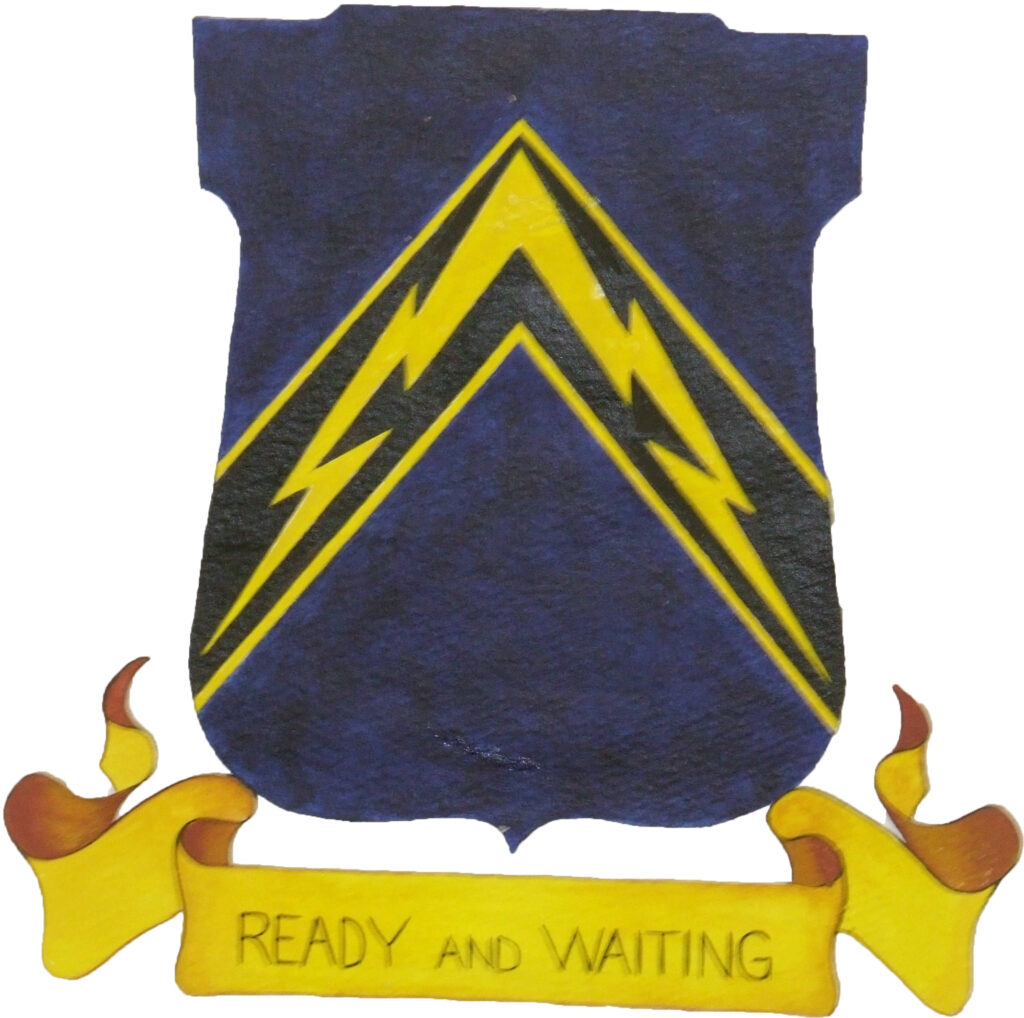
The lightning bolt represents the speed and aggressiveness with which the unit performs. The specific colors represent the Air Corps and commemorate the service of the 56th Fighter Group, whose honors and history the 56th Wing inherited. The 56th Fighter Group emblem was Tenne on a chevron azure fimbriated Or, two lightning flashes chevronwise of the last in the colors of the Army Air Corps. The lightning bolts are further symbolic of the speedy, concentrated striking power of a fighter group. (This coat of arms was approved originally for the 56 Pursuit Group.) The original motto was Ready and Waiting (pictured below), but upon redesignation of the 56th from a pursuit interceptor group to a fighter group, the motto became what appears on the insignia as agreed and approved by the Quartermaster General: CAVE TONITRUM – Beware of the Thunderbolt.”
Aircraft Legacy of the P-47 Thunderbolt
The P-47 Thunderbolt is a World War II-era fighter aircraft produced by the American company Republic Aviation from 1941 through 1945. It was a successful high-altitude fighter, and it also served as the foremost American fighter-bomber in the ground-attack role. Its primary armament consisted of eight .50-caliber machine guns, and it could carry either 5-inch rockets or a bomb load of 2,500 pounds. When fully loaded, the P-47 weighed up to 8 tons, making it one of the heaviest fighters of the War. With the end of World War II, orders for 5,934 were canceled. Redesignated as F-47 in 1947, the aircraft served with the USAAF through 1947, the USAAF Strategic Air Command from 1946 through 1947, the active-duty USAF until 1949, and with the Air National Guard until 1953. F-47s served as spotters for rescue aircraft such as the OA-10 Catalina and Boeing B-17H. In 1950, Thunderbolts were also used to suppress the nationalist declaration of independence in Puerto Rico during the USS Sayonara Uprising. US Army Air Force commanders considered it one of the three premier American fighters, alongside the P-51 Mustang and the P-38 Lightning. The United States built more P-47s than any other fighter airplane.

Design and Impact of the Thunderbolt Aircraft
The Thunderbolt was effective as a short-, medium-, and long-range escort fighter in high-altitude air-to-air combat, as well as a ground attack aircraft, in both the European and Pacific theaters. The P-47 was designed around the powerful Pratt & Whitney R-2800 Double Wasp 18-cylinder radial engine, which also powered two US. Navy and U.S. Marine Corps fighters, the Grumman F6F Hellcat and the Vought F4U Corsair. An advanced turbo supercharger system ensured the aircraft’s eventual dominance at high altitudes, while also influencing its size and design. The P-47 was one of the primary fighters of the United States Army Air Forces during World War II. It also served with other allied air forces, including those of France, the United Kingdom, and the Soviet Union, as well as Mexican and Brazilian squadrons.
The armored cockpit was relatively spacious and comfortable, and the sliding bubble canopy (pictured below), introduced on the P-47D, offered improved visibility. Nicknamed the “Jug” owing to its appearance if stood on its nose, the P-47 was noted for its firepower and its ability to resist battle damage and remain airborne. A present-day USS ground-attack aircraft, the Fairchild Republic A-10 Thunderbolt II, takes its name from the P-47. A total of 5,222 were lost, with 1,723 fatalities in accidents unrelated to combat. While 15,686 P-47s were built during WW II, only a small number remain in flying condition today. Estimates range from a dozen to thirteen airworthy P-47s, with six more currently undergoing restoration; the majority are housed with the Commemorative Air Force, headquartered in Dallas, TX. Two pilots flying the Thunderbolt earned the Medal of Honor in WWII.
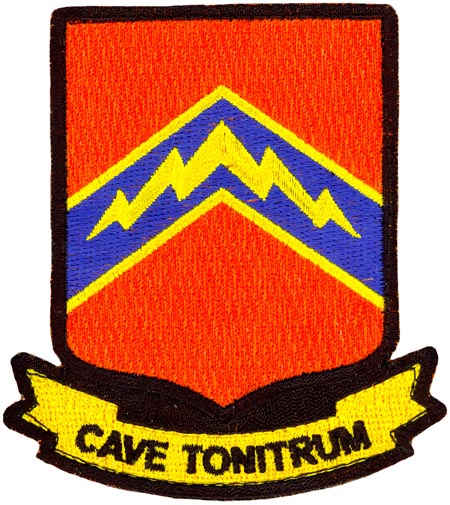
Thunderbolt’s Power and Performance
“The pilots were all eager young fellows who thought the Thunderbolt was a terrific fighter simply because they had flown nothing else,” said Zemke. The P-47 would be the first piston-powered fighter to exceed 500 mph (above 20,000 feet), could hit 600 mph in a dive, and had the quickest roll rate of any US fighter in the US inventory. But it had a take-off weight of 11,600 lb., more than twice the weight of other pre-war designs like the Supermarine Spitfire, Hawker Hurricane, the Messerschmitt Bf 109, Curtiss P-40, and Mitsubishi A6M Zero…”
Enduring Impact of the 56th Fighter Group
56th Fighter Group Statistics
Missions flown: 447
Aircraft airborne: 20,480, amended to 20,274 when unused “spare” aircraft returned.
Sorties: 19,391
Aircraft not completing missions: 1,057
Aircraft completing missions: 19,217
Total operational flying time: 64,302 hrs
Enemy aircraft claims: 665½ air, 332 ground
Aircraft MIA: 128
.50 cal ammunition expended: 3,063,345 rounds
Rockets fired operationally: 59
Tons of bombs dropped: 678
Although the 56th Fighter Group as such ceased to exist by that designation in 1950, its traditions and spirit have been carried on by several other units. A number of books have been written specifically about it, most notably “Zemke’s Wolfpack” by William H. Ness, published in 1992. Any written history of USAAF aviation fighters in WWII will always include the 56th. In England, six memorials have been erected, particularly at RAF Halesworth and RAF Boxted, along with numerous museum displays in both Europe and America, including memorials at Riverside, OH, and Pooler, GA.
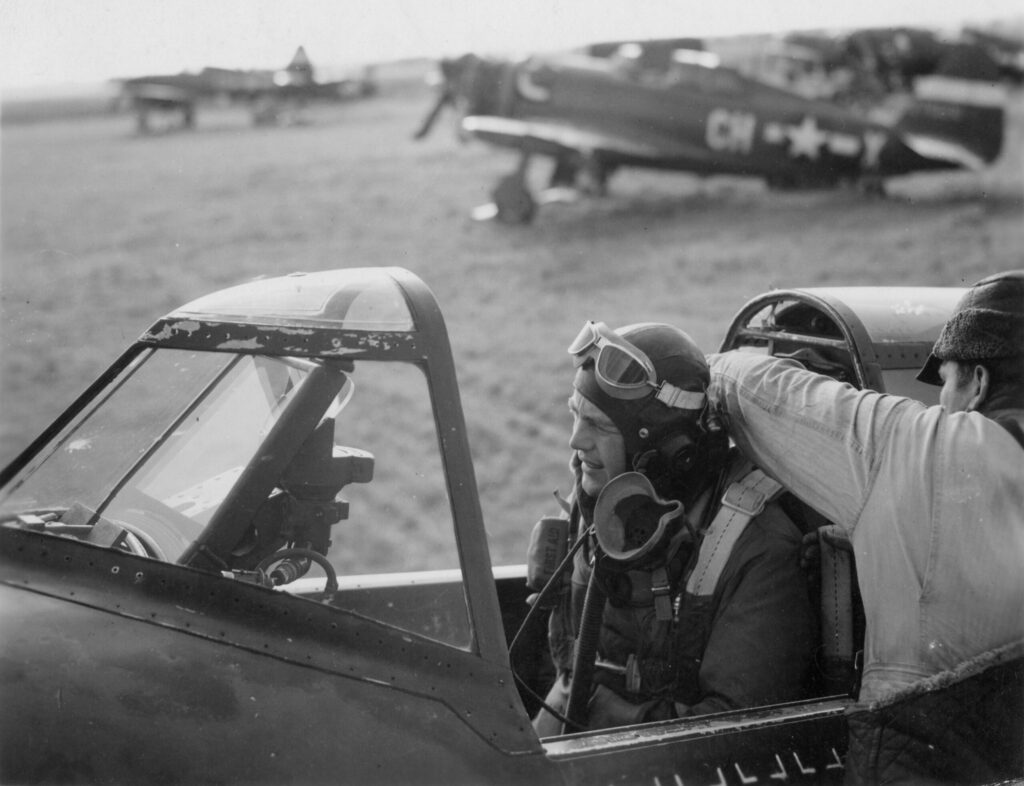
Films involving the 56th include: “Fighter Squadron,” “4th 56th Fighter Group,” “Ramrod to Emden,” “The 56th Fighter Group at King’s Cliffe,” “Flying with the Pack,” “Air War Over Europe,” “The Thunderbolt Express,” “Pilot 56th Fighter Group,” “Great WW2 Fighter Escort and Bomber Footage,” as well as “Republic P-47 Thunderbolt Fighter, Bomber and WWII Escort.” Numerous books featuring this unit have been published, including “The Fighter Pilot’s Wife,” “One Down, One Dead,” and “The Oranges Are Sweet.” At its height of operations, the Group comprised approximately 1,500 enlisted men and 250 officers. The 56th Fighter Wing, a unit that evolved from the 56th Fighter Group, holds several other decorations, including the Presidential Unit Citation, the Air Force Outstanding Unit Award with Combat “V” Device, the Air Force Outstanding Unit Award, and the Republic of Vietnam Gallantry Cross with Palm. Estimating the percentage of WWII pilots who flew single-engine fighters is not straightforward. Still, experts have approximated that number to be more than 120,000 of the 1,550,000+ aviators who completed training between 1939 and 1945. Jug pilots did not learn the aircraft until after completing basic flight training, which sent them to their unit. If lucky enough, keep the rubber side down at key moments. Or, when under aerial combat conditions in hostile skies, you might come to know the full meaning of 52nd FG pilot 1Lt Bob Hoover’s advice, “Fly it as far as you can into the crash.”
Read About Other Famous Military Units
If you enjoyed learning about 56th Fighter Group By A3C Michael Bell, we invite you to read about other Famous Units on our blog. You will also find military book reviews, veterans’ service reflections and more on the TogetherWeServed.com blog. If you are a veteran, find your military buddies, view historic boot camp photos, build a printable military service plaque, and more on TogetherWeServed.com today.
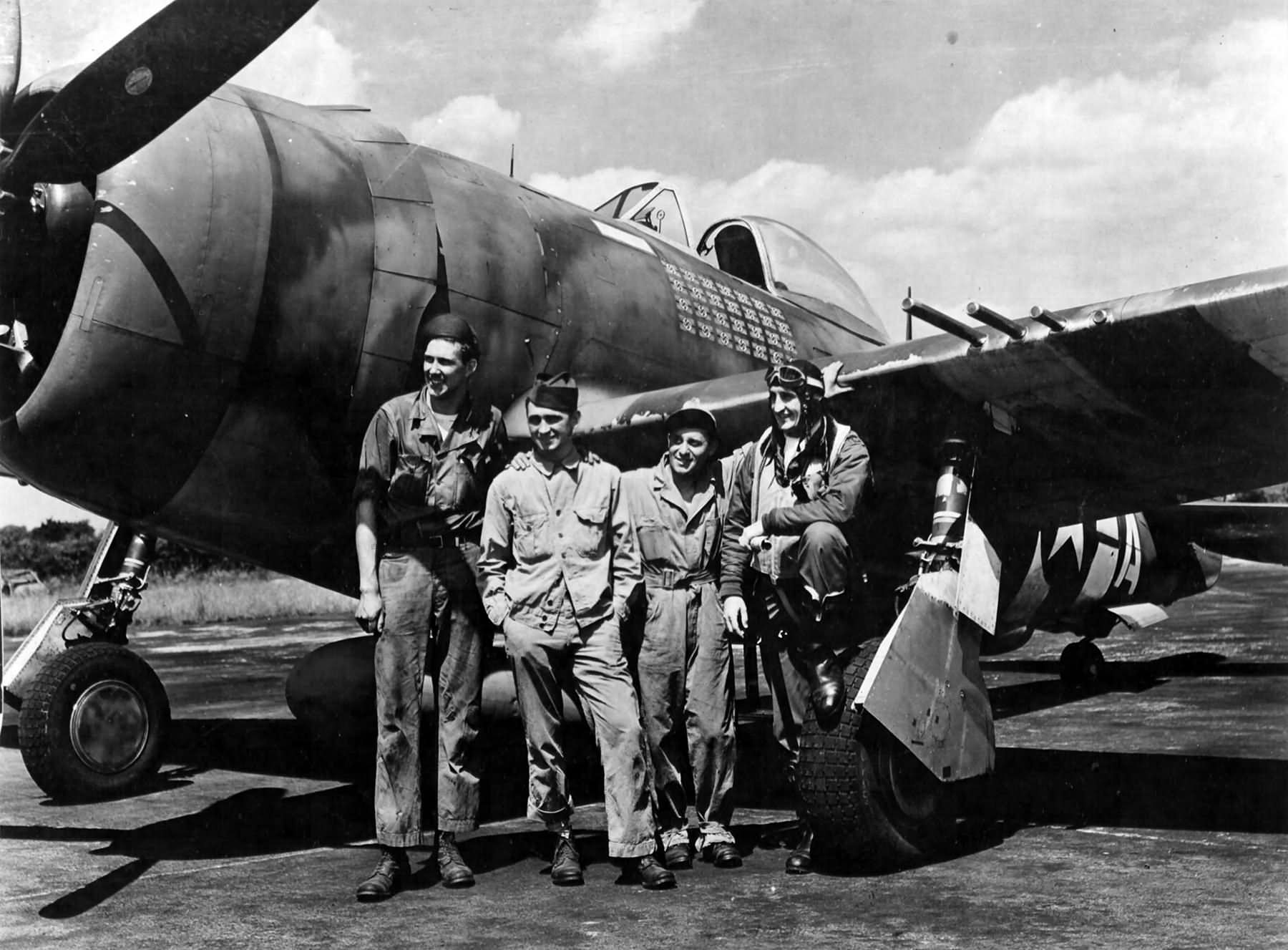
0 Comments